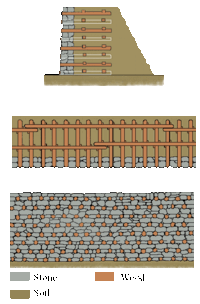47:
163:
closed up in front by large stones. These being thus laid and cemented together, another row is added above, in such a manner, that the same interval may be observed, and that the beams may not touch one another, but equal spaces intervening, each row of beams is kept firmly in its place by a row of stones. In this manner the whole wall is consolidated, until the regular height of the wall be completed. This work, with respect to appearance and variety, is not unsightly, owing to the alternate rows of beams and stones, which preserve their order in right lines; and, besides, it possesses great advantages as regards utility and the defense of cities; for the stone protects it from fire, and the wood from the battering ram, since it being mortised in the inside with rows of beams, generally forty feet each in length, can neither be broken through nor torn asunder.
30:
381:
46:
22:
369:
67:
162:
But this is usually the form of all the Gallic walls. Straight beams, connected lengthwise and two feet distant from each other at equal intervals, are placed together on the ground; these are morticed on the inside, and covered with plenty of earth. But the intervals which we have mentioned, are
357:(The definitive modern reference on hillfort construction, with extensive descriptions, comparative analysis, photographs of modern reconstructions, and even results of experiments burning reconstructed walls.)
287:
322:
354:
339:
385:
411:
312:
154:
373:
416:
406:
256:
228:
200:
40:
104:
350:
335:
126:
193:
401:
185:
87:
327:
395:
318:
249:
235:
232:– characterised by upright wooden posts in the outer wall, typical in central Europe.
149:
130:
29:
238:– inner and outer stone walls reinforced with inner horizontal timber tie beams.
380:
267:
148:
The technique of construction and the utility of the walls was described by
21:
368:
189:
94:
91:
59:
122:
transverse cross beams at approximately 2 ft (60 cm) intervals
66:
262:
181:
99:
342:(Contains the cross-section of Huelgoat drawn by Mortimer Wheeler.)
177:
65:
45:
28:
20:
173:
172:
About 30 structures of this type have been excavated, mainly in
125:
longitudinal timbers laid on the cross beams and attached with
25:
Artistic reconstruction of typical murus gallicus 100 BC
139:cross beams protruding through the stone facing
8:
176:, but extending to the upper reaches of the
223:contrasts with other construction styles:
215:Comparison with other construction styles
16:Type of defensive wall from the Iron Age
279:
129:joints, nails, or iron spikes through
7:
14:
379:
367:
192:, was excavated and reported by
314:Commentaries on the Gallic Wars
86:is a method of construction of
386:Commentaries on the Gallic War
155:Commentaries on the Gallic War
115:The distinctive features are:
1:
433:
107:period in Western Europe.
184:. The example at the sea
33:Reconstructed section of
207:wall was rebuilt in the
296:Perseus Digital Library
188:of Le Camp d'Artus, at
165:
74:
63:
43:
26:
347:Celtic Fortifications
160:
144:Technique and utility
69:
49:
32:
24:
376:at Wikimedia Commons
345:Ian Ralston (2006),
119:earth or rubble fill
412:Fortification lines
257:Pfostenschlitzmauer
229:Pfostenschlitzmauer
209:pfostenschlitzmauer
136:outer stone facing
75:
64:
44:
27:
384:Works related to
372:Media related to
332:The Ancient Celts
424:
383:
371:
300:
299:
288:"Julius Caesar,
284:
194:Mortimer Wheeler
90:used to protect
432:
431:
427:
426:
425:
423:
422:
421:
417:Iron Age Europe
392:
391:
364:
309:
304:
303:
286:
285:
281:
276:
245:
217:
186:promontory fort
170:
146:
113:
88:defensive walls
17:
12:
11:
5:
430:
428:
420:
419:
414:
409:
404:
394:
393:
390:
389:
377:
374:Murus gallicus
363:
362:External links
360:
359:
358:
343:
328:Barry Cunliffe
325:
308:
305:
302:
301:
278:
277:
275:
272:
271:
270:
265:
260:
253:
244:
241:
240:
239:
233:
221:murus gallicus
216:
213:
205:murus gallicus
169:
166:
145:
142:
141:
140:
137:
134:
123:
120:
112:
111:Basic features
109:
79:Murus gallicus
72:murus gallicus
52:murus gallicus
50:Reconstructed
36:murus gallicus
15:
13:
10:
9:
6:
4:
3:
2:
429:
418:
415:
413:
410:
408:
405:
403:
400:
399:
397:
388:at Wikisource
387:
382:
378:
375:
370:
366:
365:
361:
356:
355:0-7524-2500-5
352:
348:
344:
341:
340:0-14-025422-6
337:
333:
329:
326:
324:
320:
319:Julius Caesar
316:
315:
311:
310:
306:
297:
293:
291:
283:
280:
273:
269:
266:
264:
261:
259:
258:
254:
252:
251:
250:Murus Dacicus
247:
246:
242:
237:
234:
231:
230:
226:
225:
224:
222:
214:
212:
210:
206:
202:
197:
195:
191:
187:
183:
179:
175:
167:
164:
159:
157:
156:
151:
150:Julius Caesar
143:
138:
135:
132:
128:
124:
121:
118:
117:
116:
110:
108:
106:
102:
101:
96:
93:
89:
85:
81:
80:
73:
68:
61:
57:
53:
48:
42:
38:
37:
31:
23:
19:
346:
331:
313:
295:
289:
282:
255:
248:
227:
220:
218:
208:
204:
198:
171:
161:
153:
147:
114:
98:
83:
78:
77:
76:
71:
55:
51:
35:
34:
18:
236:Dacian Wall
203:an earlier
84:Gallic wall
407:Hill forts
396:Categories
290:Gallic War
274:References
70:Design of
268:Titelberg
95:hillforts
330:(1997),
243:See also
201:Manching
190:Huelgoat
168:Examples
92:Iron Age
62:, France
60:Bibracte
41:Manching
39:wall at
307:Sources
292:, 7.23"
263:Kelheim
211:style.
152:in his
131:augered
127:mortice
105:La Tene
103:of the
56:oppidum
54:at the
402:Oppida
353:
338:
182:Danube
100:oppida
178:Rhine
133:holes
351:ISBN
336:ISBN
323:7.23
219:The
180:and
174:Gaul
97:and
199:At
82:or
58:of
398::
349:,
334:,
321:,
317:,
294:.
196:.
158::
298:.
Text is available under the Creative Commons Attribution-ShareAlike License. Additional terms may apply.



